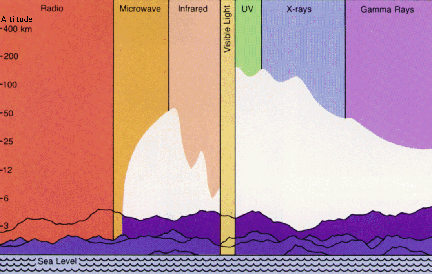While the entire
electromagnetic spectrum allows us
to view phenomenon a variety of different ways, we
are limited as to what we can see - at least on
Earth. Our
atmosphere is a life preserving blanket
of protection from particles like microwave, high
energy ultraviolet and gamma rays.
However, at these
frequencies we can learn a lot by
studying phenomenon such as accretion disks around
black holes and
quasars - and these are best "viewed" from space.
The solution is to
overcome the natural limitations of our
atmosphere
and place tools capable of viewing high energy
phenomenon in orbit around the
Earth, high above the atmosphere.
The image below demonstrates what we can see on
Earth:

Only radio waves and the visible spectrum are
viewable from the surface, however with a
telescope
on top of a high mountain (like the Keck Observatory
on Mauna Kea, Hawaii) it is possible to view objects
in the near-infrared.
Back to Top
|

